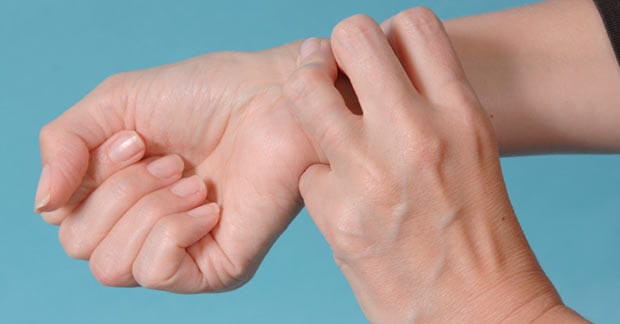Carpal tunnel syndrome (CTS) basically occurs when pressure is applied to the median nerve as it travels through the wrist on the palm side resulting in numbness, tingling, pain, and later, weakness of the grip and pinch functions. But, the median nerve can be pinched at many other locations as it courses down from the neck to the hand, which is why chiropractors examine and treat the CTS patient from the neck down! The median nerve has been described as the “eye of the hand,” as it is one of the three major nerves formed from the brachial plexus—that “highway” of nerves made up of the C5-T2 roots leaving the neck and merging together to eventually form the three main nerves of the arm. Because the median nerve function regulates pinch and grip strength, buttoning a shirt, writing a note, driving a car, and even sleeping are ALL affected by a median nerve pinch. But WHAT is CTS? Let’s take an “inside” look!
We know that fast, repetitive motion-related jobs like meat or fish packing plants, assembly line work, sewing occupations, and the like can cause CTS over time. Look at the palm side of your wrist and wiggle your fingers. Do you see ALL THE MOVEMENT that occurs just before the wrist in the forearm? That motion is coming from the tendons, which like shoe strings, attach the forearm muscles to the fingers. Notice ALL the movement in your forearm muscles closer to the elbow—that’s a lot of motion! There are nine tendons that are covered by a lubricating sheath that help the fast moving tendons reduce friction, thus decreasing the chances for heat build up, swelling (inflammation), and subsequent pain and loss of function. But, there is a limit or threshold that the tendons and sheaths can withstand before they just can’t keep up. These nine tendons and sheaths are quite tightly packed together as they leave the forearm and enter the carpal tunnel.
The carpal tunnel is made up of eight small wrist bones—the “carpal bones”—ANYTHING that makes that tunnel more narrow can effectively cause CTS. If we look at what happens INSIDE the tunnel in the CTS patient, the venous blood flow and nerve flow (called “axonal transport”) is blocked when the PRESSURE inside the tunnel occurs. We all know what it feels like when a blood pressure cuff is inflated on our arm—if it’s pumped up too high or left on too long, the arm REALLY HURTS! That’s because the blood can’t get past the inflated cuff and oxygen can’t get to our muscles and tissues past the cuff and IT CAUSES PAIN!
To give you an appreciation of the pressure difference between the normal vs. CTS wrist, normally, the pressure ranges between 2 and 10 mmHg. We pump up a blood pressure cuff to about 150-200 mmHg when we take blood pressure, so this is NOT MUCH! This 2-10 mmHg pressure increases when we change the position of our fingers, wrist and forearm with wrist extension (bending the hand backwards), causing the greatest pressure increase. This is why doctors of chiropractic commonly fit the CTS patient with a wrist “cock-up” splint to be worn at night since you can’t control your wrist position when you sleep and any bent position increases the pressure and can wake you up due to numbness, tingling, pain prompting you to shake and flick your hands and fingers until they, “…wake up.” When CTS is present, the pressure inside the tunnel goes up exponentially, meaning NOT 2 or 3 times, but 6, 12, 24 times what is normal and even higher! Now, if you add wrist bending (extension > flexion), the pressure REALLY gets high and it doesn’t take long for the nerve pinch and blood loss to wake us up. We’ve previously talked about other conditions that can make developing CTS more common or make it worse like hypothyroid, diabetes, arthritis, kidney disease, and more. AGAIN, this is because an increase is pressure results from these conditions (increased swelling = increased pressure = increased symptoms). Your doctor of chiropractic will guide and manage your care through the healing process of CTS using a conservative, NON-SURGICAL treatment approach—TRY THIS FIRST!





